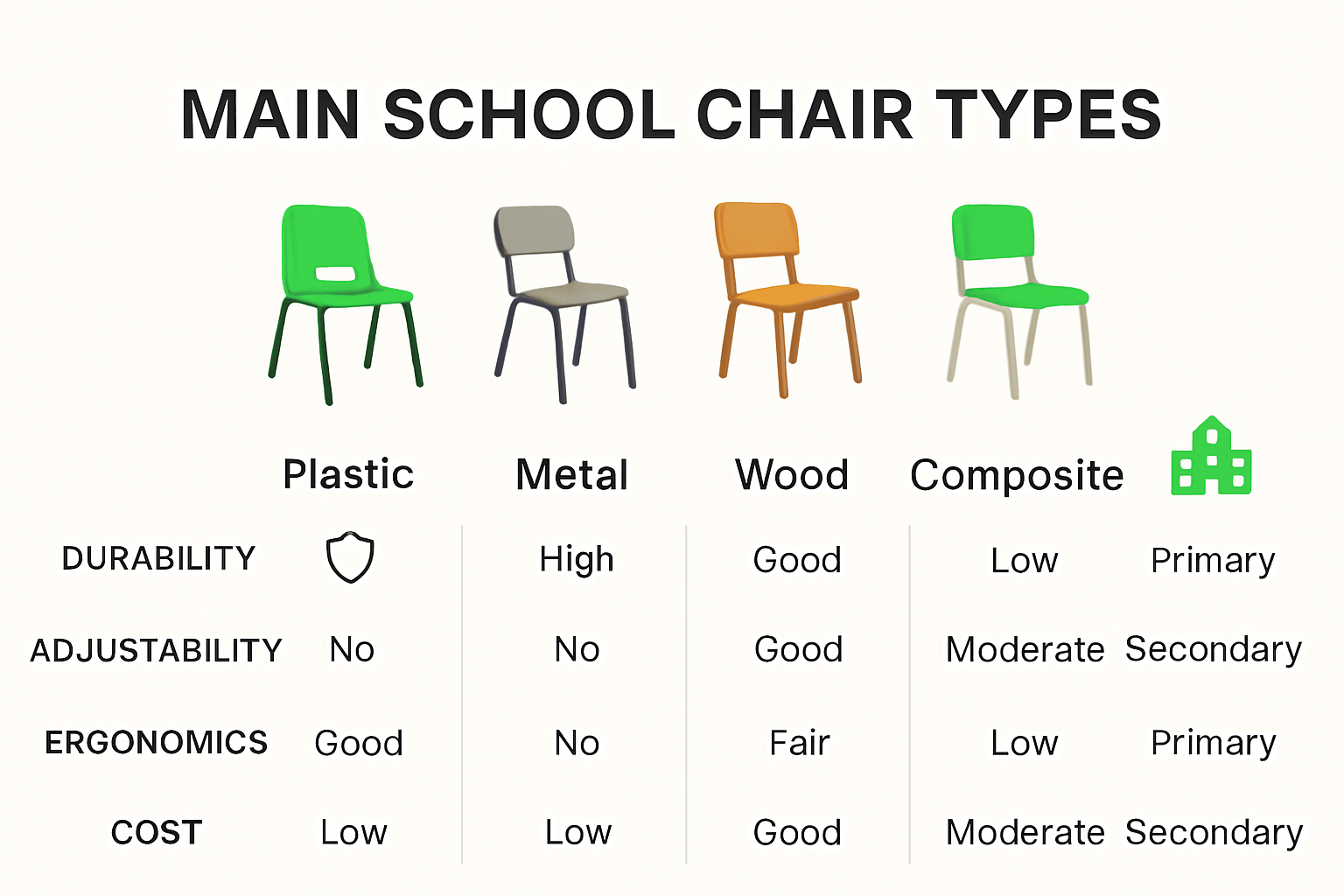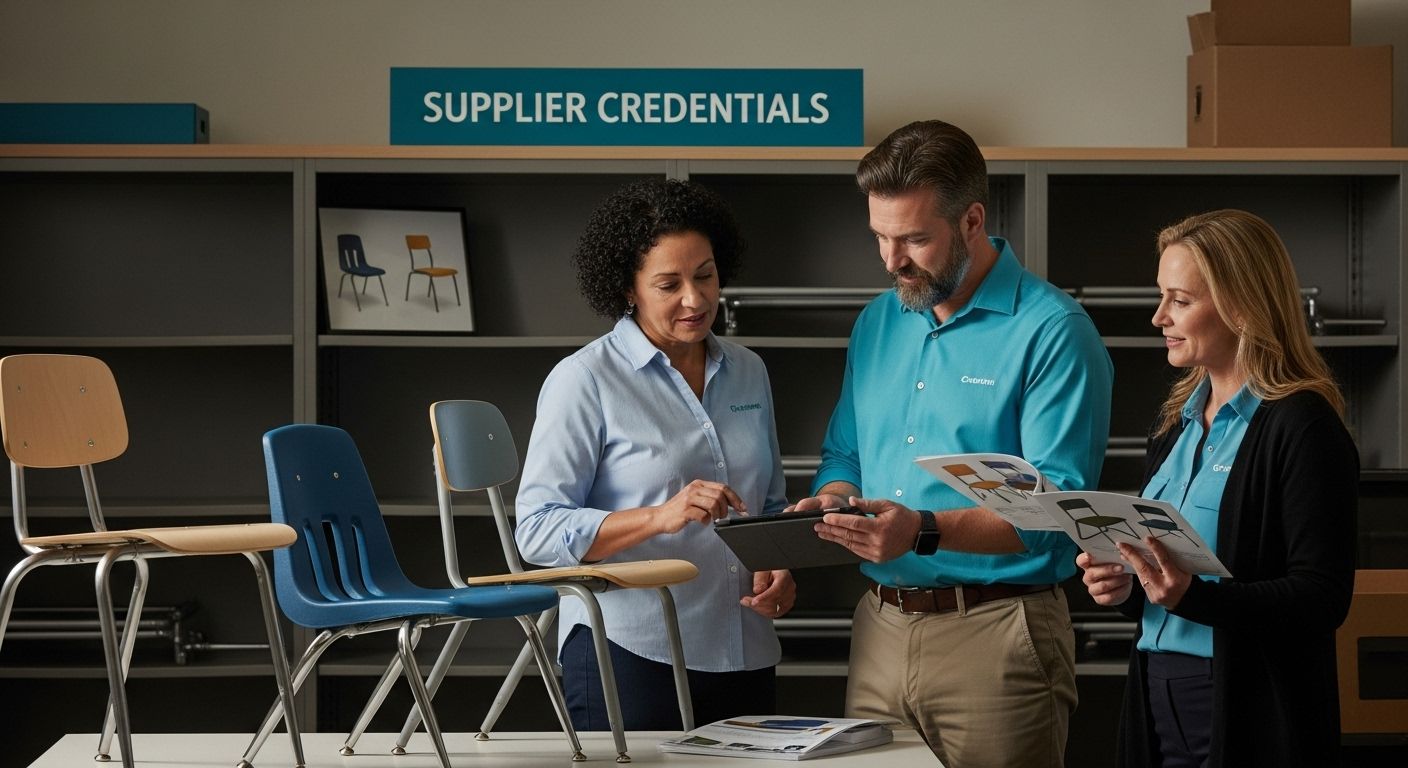Choosing School Chairs: Practical Guide for South Africa
Aug 16, 2025
Choosing School Chairs: Practical Guide for South Africa

Choosing the right school chairs can change the whole learning experience for students around South Africa. Most chairs might look the same and seem like a small detail. But the reality is, a study found that standard classroom chairs fail to fit over 70 percent of students properly, leading to poor posture and discomfort. This mismatch does not just make kids fidgety, it can actually affect their health and how well they concentrate in class.
Table of Contents
- Key Factors When Choosing School Chairs
- Comparing Chair Types And Materials
- Ensuring Comfort And Safety Standards
- Finding Trusted School Chair Suppliers
Quick Summary
| Takeaway | Explanation |
|---|---|
| Prioritize ergonomic design | Ergonomic chairs help prevent musculoskeletal issues and support student comfort and health during class. |
| Choose durable materials | Select chairs made from robust materials to withstand daily classroom wear and tear, ensuring longevity and ease of maintenance. |
| Ensure safety compliance | Chairs must meet safety standards to protect students from injury with features like stable bases and smooth edges. |
| Assess supplier credentials | Evaluate suppliers based on safety compliance, quality assurance, and ability to provide post-purchase support. |
| Consider local sourcing options | Local suppliers understand regional needs better and can offer customized solutions for diverse educational environments. |
Key Factors When Choosing School Chairs
Choosing the right school chairs is crucial for creating a comfortable and productive learning environment. The selection process involves carefully considering multiple factors that impact student health, comfort, and academic performance. Understanding these key elements will help schools make informed decisions that support student well-being and educational effectiveness.
Ergonomic Design and Student Comfort
Research from Cornell University’s Ergonomics Department emphasizes the critical importance of proper chair design for students. Ergonomic chairs play a fundamental role in preventing musculoskeletal issues and supporting students’ physical development. The ideal school chair must accommodate the diverse body sizes and shapes of students, providing adequate support for growing bodies.
Adjustability is a paramount consideration. Chairs should offer height-adjustable features that allow students to maintain proper posture and reduce the risk of physical strain. A study published in the National Center for Biotechnology Information revealed significant mismatches between standard classroom furniture and students’ body dimensions, highlighting the need for more adaptive seating solutions.
Material Durability and Classroom Practicality
School chairs must withstand significant daily use and abuse. The selected chairs should be constructed from robust materials that can endure constant movement, potential impacts, and varying environmental conditions. Durability goes beyond mere physical strength - it encompasses resistance to stains, ease of cleaning, and long-term structural integrity.
Consider chairs made from high-quality materials like reinforced plastics, metal frames, or composite materials that offer a balance between lightweight design and exceptional strength. The chairs should be easy to clean, resistant to bacterial growth, and capable of maintaining their structural and aesthetic qualities over extended periods of use.
Safety and Functional Considerations
Safety remains a paramount concern when selecting school chairs. This involves multiple aspects beyond simple structural integrity. Chairs should have smooth edges to prevent potential injuries, stable base designs that minimize tipping risks, and construction that meets stringent safety standards for educational environments.
Furthermore, the chairs should support different learning configurations. Modern educational approaches often require flexible seating arrangements, so chairs that can be easily moved, stacked, or rearranged provide additional value. Consider the overall classroom design and how the chairs will interact with other furniture and learning spaces.
Making an informed decision requires careful evaluation of these critical factors. Schools must balance comfort, durability, safety, and functionality to create optimal learning environments that support students’ physical and educational needs. Learn more about our ergonomic seating solutions that address these essential considerations for educational spaces.
Comparing Chair Types and Materials
Selecting the appropriate chair type and material is a critical decision for schools seeking to create effective and comfortable learning environments. Different materials and chair designs offer unique advantages and challenges, making it essential to understand the characteristics of various options available in the South African educational market.
Plastic and Polypropylene Chairs
Research from the Education Resources Information Center highlights the growing popularity of plastic and polypropylene chairs in educational settings. These materials offer significant advantages for school environments. Lightweight and highly durable, plastic chairs provide excellent resistance to wear and tear, making them ideal for high-traffic classroom settings.
Polypropylene chairs stand out for their versatility and practical benefits. They are easy to clean, moisture-resistant, and can withstand frequent sanitization - a crucial feature in maintaining hygienic learning spaces. The material’s flexibility allows for ergonomic designs that can accommodate different student body types and provide improved comfort compared to traditional rigid seating options.
Metal and Composite Frame Chairs
A peer-reviewed study in the International Journal of Environmental Research and Public Health emphasizes the importance of structural integrity in school furniture. Metal and composite frame chairs offer exceptional durability and strength, making them a preferred choice for long-term educational environments. Steel frames, in particular, provide robust support while maintaining a relatively lightweight design.
Composite materials represent an innovative approach to school chair construction. These chairs combine multiple materials to maximize performance, typically integrating metal frames with ergonomic plastic or wood seat surfaces. This approach allows for enhanced adjustability, improved weight distribution, and better overall student comfort. The ability to create chairs that can be easily adapted to different student sizes makes composite chairs an increasingly attractive option for schools seeking flexible seating solutions.
Wooden Chairs and Traditional Designs
Traditional wooden chairs continue to play a significant role in educational furniture. While they may lack some of the advanced features of modern materials, wooden chairs offer aesthetic warmth and a classic design that remains popular in many school settings. High-quality wooden chairs can provide excellent durability when constructed from robust materials and properly maintained.
However, wooden chairs often have limitations in terms of adjustability and ergonomic support. They tend to be heavier and less flexible compared to modern plastic or composite designs. Schools must carefully consider the trade-offs between traditional aesthetics and the functional requirements of contemporary learning environments.
To help you quickly compare the strengths and limitations of different types of school chairs mentioned in the article, the following table summarises key features for each main chair type used in South African educational settings:
| Chair Type | Key Advantages | Typical Limitations |
|---|---|---|
| Plastic / Polypropylene | Lightweight, durable, easy to clean, moisture-resistant, ergonomic designs possible | May lack classic aesthetic, can be less sturdy than metal options |
| Metal / Composite Frame | Very strong and durable, offers adjustability, accommodates growth, improved weight distribution | Can be more expensive, may be less comfortable if not well-designed |
| Wooden / Traditional | Classic looks, robust if well-made, warm aesthetic | Usually heavy, less ergonomic, limited adjustability |
Ultimately, the choice of chair type and material depends on multiple factors including budget, classroom design, student age groups, and specific educational requirements. Explore our comprehensive range of classroom seating solutions to find the perfect fit for your educational space. Careful consideration of material properties, durability, comfort, and adaptability will ensure you select chairs that support student learning and well-being.

Ensuring Comfort and Safety Standards
Ensuring comfort and safety standards for school chairs is a critical responsibility that goes beyond mere furniture selection. It encompasses a comprehensive approach to protecting students’ physical health, preventing potential injuries, and creating an environment that supports optimal learning conditions.
Ergonomic Guidelines and Health Considerations
Research published in the International Journal of Environmental Research and Public Health reveals the profound impact of furniture design on students’ physical well-being. Poorly designed chairs can contribute to long-term musculoskeletal issues, potentially affecting students’ posture, spinal development, and overall physical health.
Ergonomic guidelines recommend chairs that support natural body alignment and provide adequate lumbar support. This means selecting chairs with adjustable features that can accommodate various student body types and ages. Key ergonomic considerations include seat height, back support angle, and the ability to maintain a 90-degree angle at the knees and hips while seated.
Safety Standards and Regulatory Compliance
School chairs must meet rigorous safety standards that protect students from potential injuries. This involves multiple critical aspects of design and construction. Chairs should have rounded edges to prevent cuts or scrapes, stable base designs that minimize tipping risks, and materials that can withstand significant daily use without compromising structural integrity.
Regulatory compliance requires chairs to pass specific safety tests that evaluate load-bearing capacity, material durability, and resistance to potential classroom hazards. Schools must verify that selected chairs meet national safety standards for educational furniture, including fire resistance, chemical stability, and age-appropriate design specifications.
Maintenance and Long-Term Safety Considerations
Safety extends beyond initial chair selection to ongoing maintenance and inspection. Regular checks for structural damage, loose components, or wear and tear are essential to maintaining a safe learning environment.
To further guide schools in their selection process, here is a summary checklist of the most important ergonomic and safety features to verify in any school chair, as outlined in the article:
| Feature | Importance/Purpose | Check in Supplier Spec? |
|---|---|---|
| Adjustable Height | Allows proper posture for different ages and body sizes | Yes |
| Lumbar/Back Support | Maintains spinal health and comfort | Yes |
| Rounded Edges | Reduces risk of injury from sharp corners | Yes |
| Stable Base | Minimises tipping risks | Yes |
| Resistant Materials | Withstands daily use and frequent cleaning | Yes |
| Safety Certifications | Meets national standards for educational furniture | Yes |
Schools should implement systematic inspection protocols that identify potential risks before they become serious safety concerns.
Additionally, proper cleaning and sanitization protocols play a crucial role in maintaining chair safety. Chairs should be constructed from materials that can withstand frequent cleaning, resist bacterial growth, and maintain their structural and aesthetic qualities over time. This is particularly important in creating hygienic learning spaces that protect students’ health.
Choosing the right school chairs requires a holistic approach that balances comfort, safety, and educational effectiveness. Discover our expert guidance on selecting the perfect classroom seating that meets the highest standards of student well-being and comfort. By prioritizing ergonomic design, safety standards, and careful maintenance, schools can create learning environments that support students’ physical and academic development.
Finding Trusted School Chair Suppliers
Selecting a reliable school chair supplier is a critical decision that impacts student comfort, safety, and overall educational experience. Schools must navigate a complex landscape of manufacturers and distributors to find partners who can consistently deliver high-quality, ergonomic, and safe seating solutions.
Evaluating Supplier Credentials and Standards
The Business and Institutional Furniture Manufacturers Association (BIFMA) provides essential guidelines for identifying reputable school furniture suppliers. Trusted suppliers should demonstrate compliance with industry-standard safety certifications, durability testing, and ergonomic design principles. Key indicators of a reliable supplier include transparent manufacturing processes, independent third-party testing results, and a proven track record of serving educational institutions.
Schools should request comprehensive documentation that proves a supplier’s commitment to quality. This includes detailed product specifications, material sourcing information, safety certifications, and evidence of ongoing product research and development. Look for suppliers who can provide comprehensive warranties and after-sales support, demonstrating confidence in their product’s long-term performance.

Local Sourcing and Customization Options
UNICEF’s procurement guidelines emphasize the importance of locally sourced furniture that meets specific educational needs. South African schools benefit from suppliers who understand local educational environments, climate considerations, and specific regional requirements. Local suppliers offer advantages such as shorter delivery times, more personalized service, and better understanding of local educational infrastructure.
Customization capabilities are another crucial factor in selecting a trusted supplier. The ability to adapt chair designs to specific classroom configurations, accommodate different age groups, and provide various color and material options demonstrates a supplier’s commitment to meeting unique institutional needs. Schools should seek suppliers who offer flexible solutions that can be tailored to different learning environments and teaching methodologies.
Long-Term Partnership and Support Considerations
CESA Purchasing insights highlight the importance of viewing supplier relationships as long-term partnerships rather than simple transactional interactions. Trusted suppliers should offer comprehensive support beyond initial purchase, including maintenance guidance, replacement part availability, and ongoing consultation about furniture selection and classroom design.
Additional support services to consider include staff training on proper furniture use, ergonomic advice, and periodic assessments of existing furniture conditions. A supplier who demonstrates commitment to ongoing educational support proves they view their role as more than just a product vendor. Schools should prioritize suppliers who show genuine interest in supporting educational environments and student well-being.
Navigating the complex landscape of school chair suppliers requires careful research, thorough evaluation, and a strategic approach. Explore our comprehensive school furniture solutions designed to meet the highest standards of comfort, safety, and educational effectiveness. By prioritizing quality, local expertise, and long-term partnership, schools can make informed decisions that create optimal learning environments.
Frequently Asked Questions
What should I consider when choosing school chairs?
When selecting school chairs, key considerations include ergonomic design for student comfort, material durability for classroom practicality, safety features, and functional adaptability to various learning configurations.
How important is ergonomic design in school chairs?
Ergonomic design is crucial as it helps prevent musculoskeletal issues, supports proper posture, and enhances student comfort during learning activities. Chairs should accommodate different body sizes with adjustability in height and lumbar support.
What materials are ideal for classroom chairs?
Ideal materials for classroom chairs include reinforced plastics and metal frames for durability, moisture resistance, and ease of cleaning. Composite materials that integrate different substances also provide a balance of strength and comfort.
How can schools ensure the safety of their school chairs?
Schools can ensure the safety of their chairs by selecting products that meet strict safety standards, regularly inspecting them for wear and tear, maintaining proper cleaning protocols, and verifying features like rounded edges and stable bases.
Upgrade Your School’s Learning Experience with Chairs that Truly Care
Are you tired of watching learners struggle with discomfort and poor posture in your classrooms? The article highlighted just how common it is for school chairs to miss the mark on comfort, ergonomics and durability. These issues can affect concentration, student health and overall classroom wellbeing. At Office Stock, we believe every learner deserves a seat that fits. We understand the real cost of mismatched school furniture, both for learners and for your school’s long-term success. That’s why we offer expertly designed ergonomic chairs and adaptable solutions specifically geared for South African educational needs. Visit Office Stock to explore premium seating that meets strict safety standards, resists daily wear, and supports the holistic development of every student.

Ready to create safer, more comfortable, and vibrant classrooms? Do not wait until discomfort or injury interrupts the school year. Explore Office Stock’s full range and take the next step toward a healthier learning environment today. Your learners deserve more than the basics—choose proven ergonomic solutions that last.
